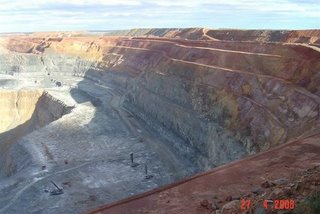
Kalgoorlie Consolidated Gold Mines' Super Pit
We took the road to Perth following the “golden” lifeblood… a pipeline carrying all the water to the Goldfields from Perth. This route had some remarkable places of interest to stop and see like the home of an old prospector (Jack Carins) who lived for 30 years in a little tin shack built of anything that he could lay his hands on.In the Goldfields Woodland National Park we camped at Boondi Rock, a granite outcrop that was ingeniously developed as a catchment for the railway water supply. The carefully constructed perimeter walls and rock lined channels that directed rainwater (run-off) into a small dam were outstanding. The ornate dragon lizards running around the rock at breakneck speed were an added bonus.

Boondi Rock catchment
We just had to stop at the notorious Rabbit Proof Fence. The 3 500km long fence had been built over the period 1901 – 1907 because of the impact of the steadily increasing rabbit population. In order to construct it 8000 tons of wire and netting were transported to Australia by ship and rail, then moved overland by horses, donkey and camel trains. After being dipped in hot coal tar the bottom of the fence was buried underground; gates were provided every 34km; yard traps were positioned every 8km to capture the rabbits; and huts were built every 48km to accommodate the inspectors and boundary riders used. Although the rabbit population declined in the late 1950’s after the introduction of myxomatosis, the threat of emus drawn to agricultural areas in search of feed during droughts presented the next problem! In the drought of 1976 for example, 100 000 hungry emus gathered along the fence. Now called the State Barrier Fence, its purpose is to reduce the threat of migrating emus as well as exclude feral dogs and goats. Any excuse will do?
The little town of Meckering was our last stop off where, on 14th Oct 1968 the entire place was destroyed by an earthquake measuring 6.9 on the Richter Scale. The quake only lasted 40 seconds but in that time all the buildings, the highway, the railway, the water supply pipeline, as well as the power and phone supplies were disrupted. However, in true Aussie fashion within 24 hours the owner of the pub moved all his liquor over the road to the Shell garage, renamed it “The Quake Arms”, and was soon selling beer reputed to be “All Shook Up”. Elvis Presley would have been proud of him?
We are now back with Sacky and Paul in Perth and experienced the spectacle of the “Million Paws Walk”. A marvellous way of ending our week seeing the array of weird and wonderful dogs brought along by thousands of RSPCA supporters is something we are glad not to have missed. The Swan estuary and the skyscrapers of the city in the background, the setting was magnificent.
Harley, Pixel and their owners on the Million Paws walk
The month of May will be spent with our daughter and husband. We will be servicing the rig, organising the inside of Getaway in readiness for the journey north.

No comments:
Post a Comment